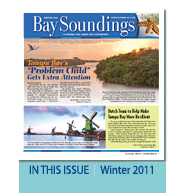 |
||||||||

Volunteers Step Up to Meet
Needs in Tampa Bay
Now, more than ever, volunteers and citizen-scientists are are stepping up to the plate to meet needs in Tampa Bay.
Volunteer involvement is critical to the success of many important survey, stewardship, education and restoration projects around Tampa Bay. Initiatives like the Audubon Society’s Christmas Bird Count (as well as the upcoming Great Backyard Bird Count) provide managers with data they would not otherwise have. The Tampa Bay Estuary Program’s Mini-Grants (pages 10-11) often teams public and private sectors for projects with significant benefits to the bay. The Egmont Key Alliance as well as volunteer organizations at Fort DeSoto, Brooker Creek and Weedon Island help maintain our natural resources and provide programming that attracts new volunteers.
Pinellas County, struggling with budget shortfalls, has created an ambitious program to recruit individuals and businesses to support its environmental and cultural resources. “It’s a brand-new program so we didn’t have any expectations, but we’re getting really good response,” says Grant Craig, volunteer coordinator for north Pinellas County.
The volunteer conservation corps (www.pinellascounty.org/volserv) will survey birds, butterflies, and native plants, gather other data in conservation lands and parks, and maintain a database that’s accessible by both volunteers and county staff.
The newest programs follow the successful “Adopt a Road” campaign but focus on Pinellas County parks and the 37 miles of the Pinellas Trail. “We think people feel good about coming out to help — they get a sense of ownership and the parks benefit in the long run.”
Two other new programs for citizen-scientists focus on invasive amphibians and butterflies and moths. REDDy — or Introduced Reptile Early Detection & Documentation – is the brainchild of Steve Johnson at the University of Florida’s campus in Plant City with partners including the National Park Service and The Nature Conservancy.
The free online course teaches volunteers how to recognize and report large invasive reptiles. REDDy-trained observers play a key role in a much larger management program by helping to detect and document the spread of established species and sightings of new species, he said. Visit http://ufwildlife.ifas.ufl.edu/reddy.shtml.
Butterflies and Moths of North America — or BAMONA — was originally developed by the USGS Northern Prairie Wildlife Research Center. Citizen scientists, or even just curious wildlife watchers, can enter data or photographs into an easily accessible location where sightings are confirmed by experts and become part of an ongoing database. Their website, www.butterfliesandmoths.org, also identifies butterflies, moths and caterpillars from photos — a service which can be extremely helpful for gardeners who aren’t sure what is destroying their plants.
Other long-running programs that count on citizen-scientists are the Frog Listening Network, now based at Lowry Park Zoo (www.lowryparkzoo.com), and Camp Bayou in Ruskin, where volunteers are now rebuilding fishing cottages from the original Giant camp on the Alafia River (www.campbayou.org) along with tracking native species and water quality.
While some volunteer opportunities require physical strength or specialized training, there are so many needs that there’s sure to be a spot for anyone who wants to make a difference in Tampa Bay.
Counting Birds for Decades
Along with restoration and education projects, volunteers in Tampa Bay collect critical data on natural resources and habitat availability. This chart was compiled by Ron Smith, owner of www.pinellasbirds.com and a long-time participant in Audubon bird counts. “Each of these species has its own story as to why the numbers have increased or decreased,” he says. “For instance, habitat loss has hampered bobwhite, meadowlark, ground-dove and towhee numbers.”
On the other hand, eagle and osprey numbers increased because DDT is no longer in use. Advanced technology and well-trained and committed volunteers — some of whom braved early morning temperatures in the 20s – also result in higher number of birds counted.
While Christmas bird counts typically need well-trained volunteers, anyone can participate in the annual Great Backyard Bird Count, scheduled for Feb. 18 to 21 this year. Visit www.birdsource.org.
Species |
1969-69 |
1980-89 |
1990-99 |
2000-99 |
2010 |
Lesser Scaup Red-breasted Merganser Northern Bobwhite Brown Pelican Great Blue Heron Great Egret Little Blue Heron Roseate Spoonbill Osprey Bald Eagle Northern Harrier Cooper’s Hawk American Kestrel Black-bellied Plover Wilson’s Plover American Oystercatcher Willet Red Knot Dunlin Laughing Gull Ring-billed Gull Herring Gull Black Skimmer Common Ground Dove Red-bellied Woodpecker Northern Flicker Loggerhead Shrike Tree Swallow Carolina Wren American Robin Northern Mockingbird Eastern Starling Northern Cardinal Eastern Meadowlark House Sparrow |
8595 243 119 516 131 165 84 0 1 6 10 0.8 59 153 70 38 260 489 1222 1628 9100 992 675 68 76 56 71 1426 37 3358 360 502 117 124 571 |
8114 178 18 846 201 301 79 1 12 6 8 1.3 25 182 12 148 438 69 588 8010 5367 731 299 37 45 41 6 589 23 4594 136 7690 55 20 993 |
4476 277 6 842 205 375 79 12 50 7 3 3.4 20 124 7 125 669 257 501 3450 1816 78 546 21 58 21 49 13 23 1198 208 8325 61 12 361 |
2688 184 0.7 1091 191 356 113 44 105 12 2.3 20.6 13.6 143 8.4 62.4 857 156 732 3398 1543 80 881 12.5 65 8 99 2 13.9 509 207 5244 74 4.9 102 |
1125 170 0 850 255 535 131 58 193 16 4 21 21 105 1 52 505 21 405 3400 900 45 890 4 110 3 92 3 11 20 270 2625 115 2 123 |
